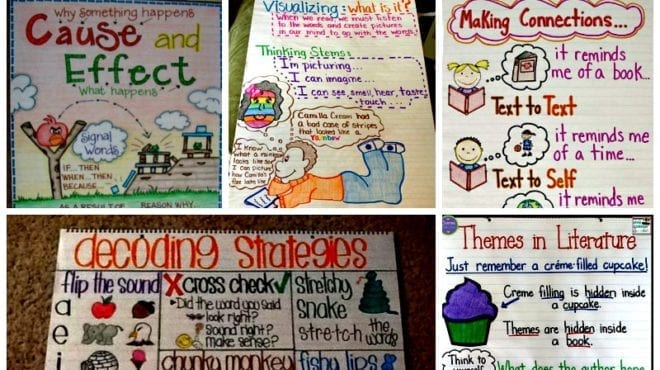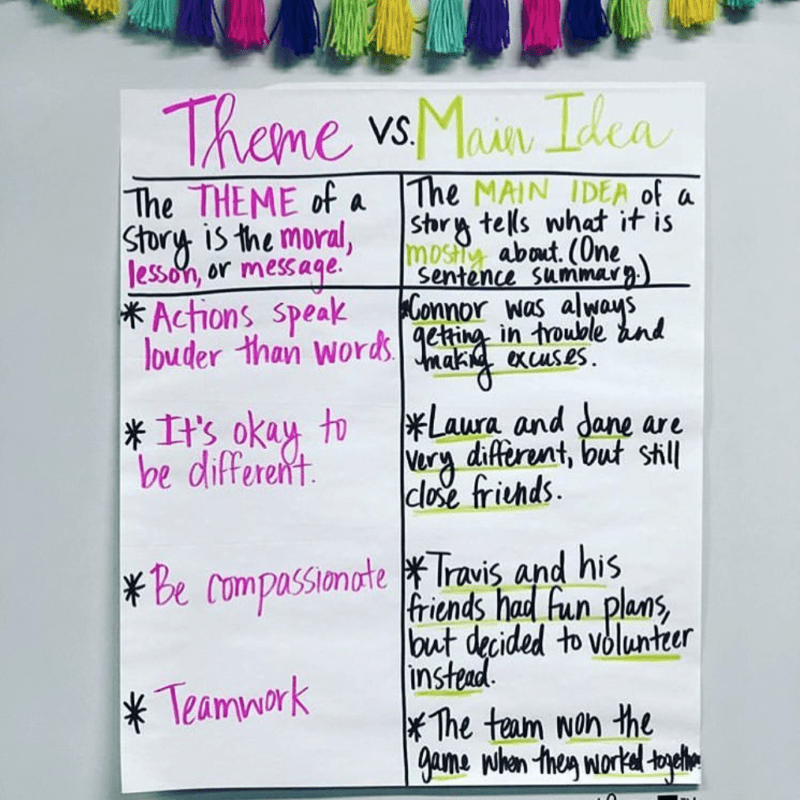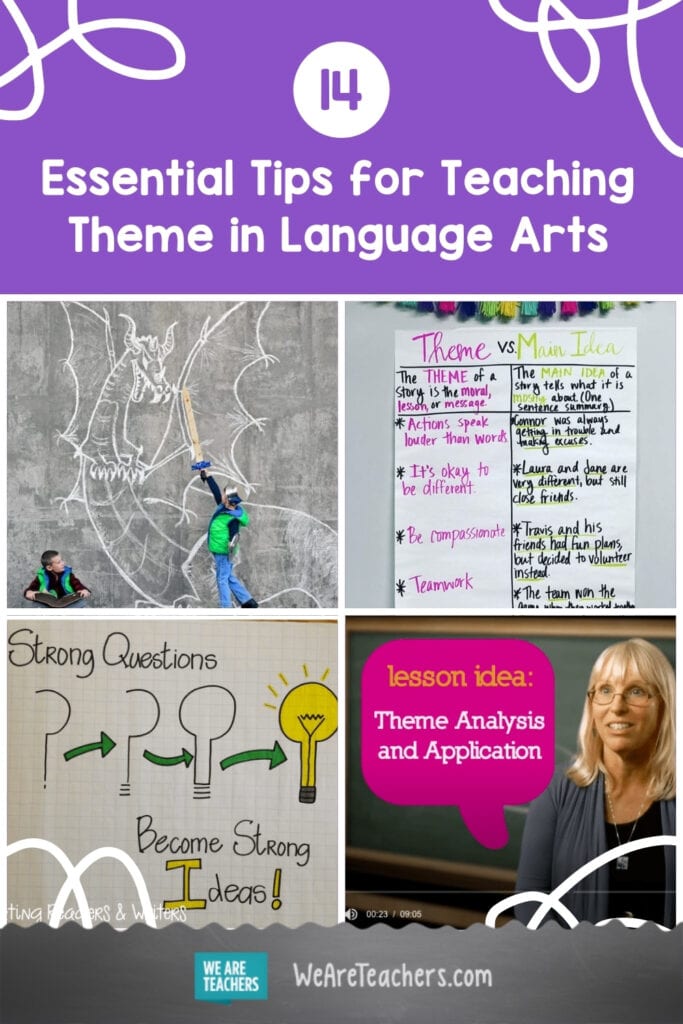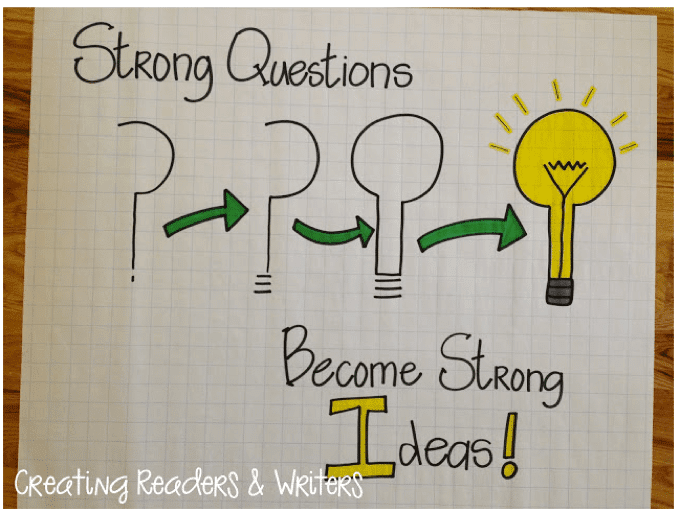How to Do Meaningfull Centers for Middle School Language Arts
When students in Becca Morris's course start listening to R.J. Palacio'due south Wonder, she looks forward to the word it will inspire, with questions like What does it mean to be a true friend?What's the role of the bystander in bullying situations? and Tin can we tell what a person is similar merely past looking at them? anchoring the conversation. It is conversations similar these that facilitate educational activity theme in linguistic communication arts. And the answers can turn reading a book into a life-changing experience for immature learners.
"Studying themes like trust, integrity, and honesty," says Rachel Claff, editorial director for the Peachy Books Foundation, "builds thoughtful earth citizens and friends, the kinds of thinkers you want to have in your classroom."
Each time students read, they're entering into a conversation with the author virtually what matters, says Jeffrey Wilhelm, distinguished professor at Boise Country University and author of Fresh Takes on Educational activity Literary Elements. At the core of that chat, yet, is comprehension. To fully explore theme, students must understand what they read and so extract ideas from the text. "You can't think with ideas unless you empathise them," says Wilhelm.
Here are 14 tips to assist your students understand theme as they read.
1. Run across your students where they are.
Programme reading and discussion effectually questions that your students are already grappling with, from What does it mean to be a good friend? to What is heroism?
When you connect your literature themes to character development and what's going on in students' lives, your discussions will hopefully resonate deeply with them. One goal with pedagogy theme, explains Jodi Libretti of the Smashing Books Foundation, is to encourage students "not simply to think about means that they can live, but the type of person they want to become."
two. Start with physical details.

Earlier they can identify and piece of work with the theme of a story, your students need to have a potent grasp of the details: setting, character, plot. When they work with theme, they have to synthesize all that information into an overarching message. Use anchor charts to outline the elements of the story or give students a graphic organizer to follow.
iii. Clarify the divergence betwixt theme and main idea.

Source: Mrs. Smith in 5th
Many students accept difficulty differentiating between the main thought and the theme. The theme is the underlying message that the author wants to convey, whereas the main idea is what the story is mostly near. Teach these concepts separately and together. You might practise identifying themes and main ideas using Disney films or the stories your students read last year in gild to accept a mutual reference point. After you review as a grade, give students a list of themes and master ideas and challenge them to work in pairs to create matches.
4. Scaffold the learning.

Theme is a difficult concept to grasp. Unlike the concreteness of setting or plot, theme is subtle and subjective. Move from simpler to more than complex class assignments to assist your students deepen their understanding. Humanities teachers Sara Kaviar and Megan O'Keefe, of the Wildwood School in Los Angeles, invite their students to work in groups to identify the theme of a fairy tale. Adjacent, they create different endings to the tale and piece of work together to identify how the new catastrophe affects the theme. Finally, students write their own plots to match a given theme. Spotter a video of how they approach pedagogy theme hither.
five. Utilise essential questions.
Source: Creating Readers & Writers
Essential questions are open-ended, idea-provoking, and important in helping students develop their understanding of the theme. Questions like Why do people comport honestly? and What makes a good friend? are ones that you can return to throughout the year to analyze how students reply. Run across how their answers alter equally yous read dissimilar authors' takes on the subject.
6. Ask story-specific questions, too.
Specific, targeted questions help focus students on the text. "Asking 'what is the theme?' sometimes strands students because information technology's as well general," says Claff. On the other hand, request questions that are more than explicit, like "Where does friendship play an important part in this story?" tin be too leading. Instead, ask questions that draw from the text and require evidence to support theme. For example, if yous're readingConstrict Everlasting, you might enquire, "Should Winnie drink the immortality water?"
7. Arroyo theme from different directions.
Be ready to phrase questions about theme a few different means because you never know which question(s) volition resonate with students. Some questions that will encourage thinking well-nigh theme are: What did the author want the states to retrieve virtually? What idea stays with you lot? andWhat will you think almost the story a twelvemonth from at present?
eight. Accept a range of answers.
Of form, for many texts, there are often multiple themes and more than one manner to express them. Be flexible when accepting students' answers to theme-based questions. Students volition often be grappling with concepts they can't fully own. For example, if a student says the theme of Tuck Everlasting is living forever is a bad idea, y'all can work with the class to discover different ways to express this idea. You might say, "Okay, what are another ways we can say that?" Guide students toward the theme rather than requiring one right respond, which can turn the give-and-take into a game of guessing the instructor's thoughts.
9. Allow students to disagree with the theme.
Allow students know that they don't accept to agree with the theme, just because they read it! Showcase two opposing themes and have students discuss which one they concord with more than. For example, yous could have a paragraph with the theme of You can always trust your friends and another paragraph with the theme of If you want something washed right, yous have to do information technology yourself.
x. Become away from the obvious.
Information technology'due south easy to tease out the theme from some stories (think: Aesop's The Ant and the Grasshopper). Challenge students with stories that don't follow a typical pattern. For example, in the Great Books unit on honesty, students read about characters who begin each story by being quack. By starting with a character who's lying, students explore deeper problems of honesty from the start. The conscientious use of stories, says Claff, opens up issues for students in an interesting real-world manner.
11. Connect your discussions to other subject areas.
Practise you see examples in social studies or current events that connect to your theme? Beginning a collection or bulletin board around your current literature theme. Students tin add examples from pop culture, history, or other reading. Assistance students connect the theme to their ain lives past assigning accept-home activities that build personal experiences effectually each theme. When students written report kindness in Great Books, they perform a random deed of kindness. And when third graders written report gratitude, they give an anonymous gift and so they can experience what it's like to not receive a give thanks-you.
12. Provide a range of reading options.
To engage students at varying reading levels, provide a pick of books on one theme. When instructor and author Laura Robb teaches about obstacles, she fills her classroom library with biographies so students can read about how unlike historical figures overcame challenges in their lives. Even when each student is reading something different, they are even so engaging with the theme in conferences and writing. One way to introduce pick is to have a read-aloud anchor text for all students, with a variety of stories to choose from for contained reading. In conferences, ask students to relate and connect their independent reading to the read aloud.
Teaching theme gets at the heart of what we desire for students—authentic, meaningful, and memorable experiences with text. Jeff Wilhelm may have put it best, "If you can read for theme, you tin participate in a democracy."
xiii. Utilize mini lessons to drive the signal home.
These seven quick mini-lessons assistance for teaching theme and how authors and artists excerpt a big idea.
1. Assess inspirational quotes.
Read inspirational words to ascertain a theme and brainstorm stories, movies, or real-life events in which you run into this theme played out.
ii. View compelling fine art.
Brand fine art a springboard to talk over themes and how they're interpreted. For example, Edvard Munch's The Scream tin can inspire a give-and-take about the theme of fearfulness and dubiousness.
3. Heed to songs.
Songs can lend themselves to a word of how artists communicate larger messages through lyrics. For case, Lee Ann Womack'south "I Promise You Dance" lends itself to a word of independence.
4. Pull out the oldies but goodies.
Fairy tales are quick hits in instruction theme—similar pulling the theme of envy from Snow White.
5. Review popular movies.
Brainstorm theme ideas from pop movies. For example, The Panthera leo Rex and responsibleness or Willy Wonka and the Chocolate Manufacturing plant and greed.
6. Sentinel a Pixar brusque
Pixar shorts are easily found on YouTube. You lot can picket them as a grade and then hone in on a theme discussion. Consider Piper, Partly Cloudy, and Lava.
seven. Judge some books by their encompass.
Postal service the covers of books you lot have read and ask students to discuss whether or not the theme is axiomatic on the comprehend.
14. Continue to assess theme throughout the year.
As the twelvemonth progresses, you'll want to know if teaching theme paid off and if students are able to identify theme independently. Here are eight suggestions for finding out if your students are getting it.
one. Utilize annotation.
Take students annotate a text with details, quotes, and other "gilded lines" that highlight the theme. Save and print our free teacher and student infographic posters on annotation.
2. Monitor reader responses.
Writing responses to the essential questions from the start to cease of a unit will help you encounter how students develop their ideas.
3. Map character growth.
Oftentimes theme comes from the way characters—usually the chief character—changes and grows throughout the story. Take students create a growth nautical chart focused on i grapheme, that marks transitions in their development.
4. Compare the theme with that of other stories.
Connecting the theme from 1 story to another shows that students grasp the theme in a broad sense.
5. Cite evidence.
Ask your students to give concrete examples from the book that demonstrate the theme. This can include quotes, summaries, or championship headings, to name merely a few.
6. Reflect.
Have students make a connection through writing and give-and-take on what the theme means to them personally and how their agreement of the theme has changed based on their reading.
7. Search for additional themes.
Many stories take more than only 1 theme—sometimes, yous simply have to dig a trivial. Using a story that students are familiar with, have them place and support a theme that's different than the one you've already studied. For case, in the story Oliver Button, students may come with themes of bullying, gender roles, and determination.
8. Mind for theme.
In reading conferences with students, train yourself to heed for specific details and examples almost theme. The more students are understanding, the better they'll be at answering questions like What does the writer want you to recall?
What are your tips for teaching theme? Come up and share in our WeAreTeachers HELPLINE group on Facebook.
Plus, our favorite anchor charts for teaching reading comprehension.

Source: https://www.weareteachers.com/11-tips-for-teaching-about-theme-in-language-arts/

0 Response to "How to Do Meaningfull Centers for Middle School Language Arts"
Post a Comment